Abstract
The relationship between P-glycoprotein expression and malignancy is controversial. We have recently found that, in osteosarcoma, multidrug resistance (MDR) is associated with a less aggressive behavior, both in vitro and in clinical settings. In this study, we evaluated whether P-glycoprotein overexpression has a cause-effect relationship with the reduced metastatic potential of MDR cells, or rather reflects a more complex phenotype. MDR1 gene-transfected osteosarcoma cell clones, showing different levels of P-glycoprotein expression, were analysed for their in vitro characteristics and their tumorigenic and metastatic ability in athymic mice. Apart from the different levels of P-glycoprotein, no significant change in the expression of surface antigens or in the differentiative features were observed in the MDR1 gene transfectants compared to the parental cell lines or control clones, obtained by transfection with neo gene alone. In contrast to controls, however, MDR1 transfectants showed a significantly lower ability to grow in semi-solid medium and were completely unable to grow and give lung metastases in athymic mice. These findings indicate that P-glycoprotein overexpression is causally associated with a low malignant potential of osteosarcoma cells, and open new insights on the role and functions of P-glycoprotein activity.
This is a preview of subscription content, access via your institution
Access options
Subscribe to this journal
Receive 50 print issues and online access
$259.00 per year
only $5.18 per issue
Buy this article
- Purchase on SpringerLink
- Instant access to full article PDF
Prices may be subject to local taxes which are calculated during checkout



Similar content being viewed by others
References
Baldini N, Scotlandi K, Barbanti-Brodano G, Manara MC, Maurici D, Bacci G, Bertoni F, Picci P, Sottili S, Campanacci M and Serra M. . 1995 N. Engl. J. Med. 333: 1380–1385.
Baldini N. . 1997 Nature Med. 3: 378–380.
Bashir I, Sikora K, Abel P and Foster CS. . 1994 Int. J. Cancer 57: 719–726.
Bénard J, Da Silva J, Teyssier JR and Riou G. . 1989 Int. J. Cancer 43: 471–477.
Biedler JL, Riehm H, Peterson RHF and Spengler BA. . 1975 J. Natl. Cancer Inst. 55: 671–677.
Biedler JL and Spengler BA. . 1994 Cancer Met. Rev. 13: 191–207.
Bradley G, Sharma R, Rajalakshimi S and Ling V. . 1992 Cancer Res. 52: 5154–5161.
Bradley G and Ling V. . 1994 Cancer Met. Rev. 13: 223–233, 1994.
Chan HSL, Thorner PS, Haddad G and Ling V. . 1990 J. Clin. Oncol. 8: 689–704.
Chan HSL, Haddad G, Thorner PS, DeBoer G, Lin YP, Ondrusek N, Yeger H and Ling V. . 1991 N. Engl. J. Med. 323: 1608–1614.
Chan HSL, Grogan TM, Haddad G, DeBoer G and Ling V. . (1997) J. Natl. Cancer Inst. 89: 1706–1715.
Chen C, Chin JE, Ueda K, Clark DP, Pastan I, Gottesman MM and Roninson IB. . 1986 Cell 47: 381–389.
Foote SJ, Thompson JK, Cowman AF and Kemp DJ. . 1989 Cell 57: 921–930.
Goldstein LJ, Galski H, Fojo A, Willingham M, Lai S, Gazdar A, Pirker R, Green A, Crist W, Brodeur GM, Lieber M, Cossman J, Gottesman MM and Pastan I. . 1989 J. Natl. Cancer inst. 81: 116–124.
Gottesman MM and Pastan I. . 1993 Annu. Rev. Biochem. 62: 385–427.
Habu S, Fukuyi H, Shimamura K, Kasai M, Nagai Y, Okumura K and Tamaoki N. . 1981 J. Immunol. 127: 34–38.
Higgins CF. . 1992 Annu. Rev. Cell Biol. 8: 67–113.
Hoffman MM, Wei L-Y, and Roepe PD. . 1996 J. Gen. Physiol. 108: 295–313.
Kerbel RS and MacDougall JR. . 1993 Drug Resistance in Oncology. Teicher BA. (ed.).. New York: Marcel Dekker 583–601.
Lincke CR, van der Bliek AM, Schuurhuis GJ, van der Velde-Koerts T, Smit JJM and Borst P. . 1990 Cancer Res. 50: 1779–1785.
Mirski SEL, Gerlach JH and Cole SPC. . 1987 Cancer Res. 47: 2594–2598.
Murphy LD, Herzog CE, Rudick JB, Fojo AT and Bates SE. . 1990 Biochemistry 29: 10351–10356.
Pastan I, Gottesman MM, Ueda K, Lovelace E, Rutherford AV and Willingham MC. . 1988 Proc. Natl. Acad. Sci. USA 85: 4486–4490.
Pinedo HM and Giaccone G. . 1995 N. Engl. J. Med. 333: 1417–1419.
Riordan JR, Rommens JM, Kerem BS, Alon N, Rozmahel R, Grzelczak Z, Zielenski J, Lok S, Plavsic N, Chou JL, Drumm ML, Iannuzzi MC, Collins FS and Tsui LC. . 1989 Science 245: 1066–1073.
Rodan SB, Imai Y, Thiede MA, Wesolowski G, Thompson D, Bar-Shavit Z, Shull S, Mann K and Rodan GA. . 1986 Caner Res. 47: 4961–4966.
Roepe PD, Wei LY, Hoffman MM and Fritz F. . 1996 J. Bioenerg. Biomembr. 28: 541–555.
Scotlandi K, Serra M, Nicoletti G, Vaccari M, Manara MC, Nini G, Landuzzi L, Colacci A, Bacci G, Bertoni F, Picci P, Campanacci M and Baldini N. . 1996 Cancer Res. 56: 2434–2439.
Serra M, Scotlandi K, Manara MC, Maurici D, Lollini PLL, De Giovanni C, Toffoli G and Baldini N. . 1993 Anticancer Res. 13: 323–330.
Thomas PM, Cote GJ, Wohlik N, Haddad B, Mathew PM, Rabl W, Aguilar-Bryan L, Gagel RF and Bryan J. . 1995 Science 268: 426–429.
Ueda K, Cardarelli C, Gottesman MM and Pastan I. . 1987 Proc. Natl Acad Sci USA 84: 3004–3008.
Acknowledgements
We thank Dr Piet Borst for providing the expression vector containing the MDR1 gene. This work was supported in part by grants from the Associazione Italiana per la Ricerca sul Cancro, the Istituti Ortopedici Rizzoli (Ricerca Corrente; Ricerca Finalizzata `Studio dei meccanismi coinvolti nella farmacoresistenza e validazione di indicatori della chemiosensibilità nei sarcomi muscolo-scheletrici') and the Ministero dell'Università e della Ricerca Scientifica e Tecnologica.
Author information
Authors and Affiliations
Rights and permissions
About this article
Cite this article
Scotlandi, K., Manara, M., Serra, M. et al. The expression of P-glycoprotein is causally related to a less aggressive phenotype in human osteosarcoma cells. Oncogene 18, 739–746 (1999). https://doi.org/10.1038/sj.onc.1202330
Received:
Revised:
Accepted:
Published:
Issue date:
DOI: https://doi.org/10.1038/sj.onc.1202330
Keywords
This article is cited by
-
Epigenetic regulation of MDR1 gene through post-translational histone modifications in prostate cancer
BMC Genomics (2013)
-
Human osteosarcoma xenografts and their sensitivity to chemotherapy
Pathology & Oncology Research (2004)
-
Identification of RB1CC1, a novel human gene that can induce RB1 in various human cells
Oncogene (2002)
-
Caveolin-1 inhibits anchorage-independent growth, anoikis and invasiveness in MCF-7 human breast cancer cells
Oncogene (2002)



